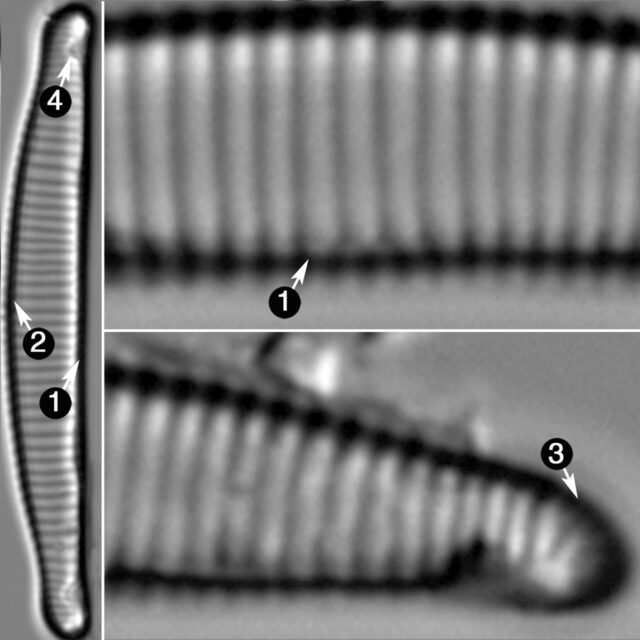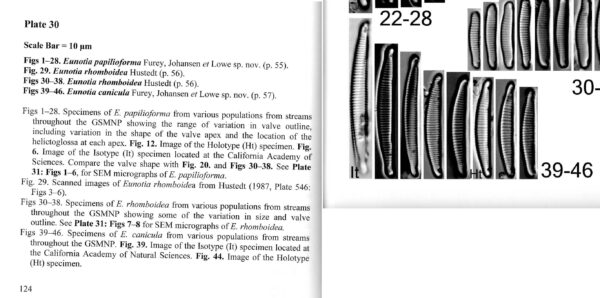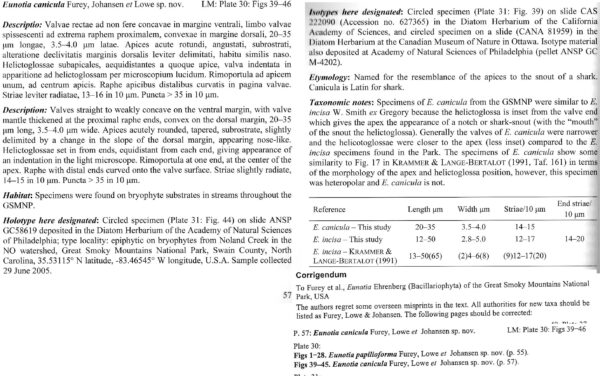Eunotia canicula
-
Category
-
Length Range20-35 µm
-
Width Range3.5-4.0 µm
-
Striae in 10 µm14-15, areolae >35
-
ContributorPaula Furey - Mar 2011
-
ReviewerRex Lowe - Apr 2011
Identification
View image metadata
Type
Description
Valves are straight to weakly concave on the ventral margin. The valve mantle is thickened at the proximal raphe ends. The dorsal margin is convex. The apices are acutely rounded, tapered, subrostrate, slightly delimited by a change in the slope of the dorsal margin, and appear nose-like. Each helictoglossa is equidistant from the midpoint of the apical axis and the apex. The helictoglossae are "set in" forming an indentation on the ventral margin. The distal raphe ends curve onto the valve surface. Striae are slightly radiate.
Autecology
To date Eunotia canicula has been found epiphytic on bryophyte substrates in streams throughout the Great Smoky Mountains National Park.
-
Size Range, µm3
-
Motility
-
Habitat
-
Waterbody
-
Distribution
- Learn more about this
Original Description
Valves straight to weakly concave on the ventral margin, with valve mantle thickened at the proximal raphe ends, convex on the dorsal margin, 20 – 35 μm long, 3.5 – 4.0 μm wide. Apices acutely rounded, tapered, subrostrate, slightly delimited by a change in the slope of the dorsal margin, appearing nose-like. Helictoglossae set in from ends, equidistant from each end, giving appearance of an indentation in the light microscope. Rimoportula at one end, at the center of the apex. Raphe with distal ends curved onto the valve surface. Striae slightly radiate, 14 – 15 in 10 μm. Puncta >35 in 10 μm.
-
AuthorFurey, Lowe and Johansen 2011
-
Length Range20-35 µm
-
Width3.5-4.0 µm
-
Striae in 10µm14-15, puncta >35
Cite This Page
Furey, P. (2011). Eunotia canicula. In Diatoms of North America. Retrieved April 19, 2024, from https://diatoms.org/species/eunotia_canicula
Responses
The 15 response plots show an environmental variable (x axis) against the relative abundance (y axis) of Eunotia canicula from all the stream reaches where it was present. Note that the relative abundance scale is the same on each plot. Explanation of each environmental variable and units are as follows:
ELEVATION = stream reach elevation (meters)
STRAHLER = distribution plot of the Strahler Stream Order
SLOPE = stream reach gradient (degrees)
W1_HALL = an index that is a measure of streamside (riparian) human activity that ranges from 0 - 10, with a value of 0 indicating of minimal disturbance to a value of 10 indicating severe disturbance.
PHSTVL = pH measured in a sealed syringe sample (pH units)
log_COND = log concentration of specific conductivity (µS/cm)
log_PTL = log concentration of total phosphorus (µg/L)
log_NO3 = log concentration of nitrate (µeq/L)
log_DOC = log concentration of dissolved organic carbon (mg/L)
log_SIO2 = log concentration of silicon (mg/L)
log_NA = log concentration of sodium (µeq/L)
log_HCO3 = log concentration of the bicarbonate ion (µeq/L)
EMBED = percent of the stream substrate that is embedded by sand and fine sediment
log_TURBIDITY = log of turbidity, a measure of cloudiness of water, in nephelometric turbidity units (NTU).
DISTOT = an index of total human disturbance in the watershed that ranges from 1 - 100, with a value of 0 indicating of minimal disturbance to a value of 100 indicating severe disturbance.

Eunotia canicula
- Ventral margin straight to weakly concave
- Dorsal margin convex
- Apices acutely rounded and nose-like
- Helictoglossae equidistant from midpoint of apical axis and apices
The ventral margin of Eunotia canicula is straight to weakly concave. The dorsal margin is convex. The apices are acutely rounded, tapered, subrostrate and nose-like in appearance. The apices are delimited by a very slight change in the slope of the dorsal margin. Helictoglossae are equidistant from the midpoint of the apical axis and...
 Diatoms of North America
Diatoms of North America








